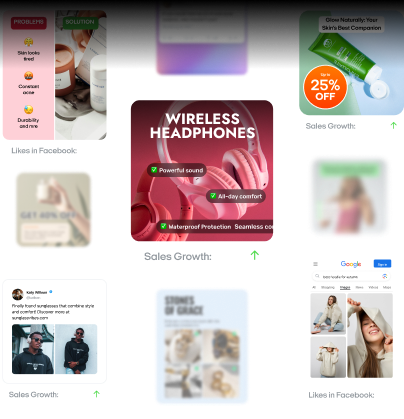Food ads that drive results: Real examples, branding, design
What makes a food ad mouthwatering and memorable? Zeely AI highlights top-performing food ad examples, branding tactics, and creative design elements that trigger appetite and action.
If your food ads aren’t converting, the issue isn’t reach — it’s weak messaging, poor visuals, or disconnected strategy. Food ads are targeted promotions that use visuals to sell dishes, push offers, or shape brand perception. They run on digital platforms, print, and outdoor formats.
According to Statista, in January 2023, advertising spending in the food category totaled $440 million in the United States. That marked a 30% drop from December 2022, when advertisers invested around $630 million. This sharp decline highlights how even major brands are scrutinizing their ad effectiveness, cutting back on spend that doesn’t perform and doubling down on campaigns that do.
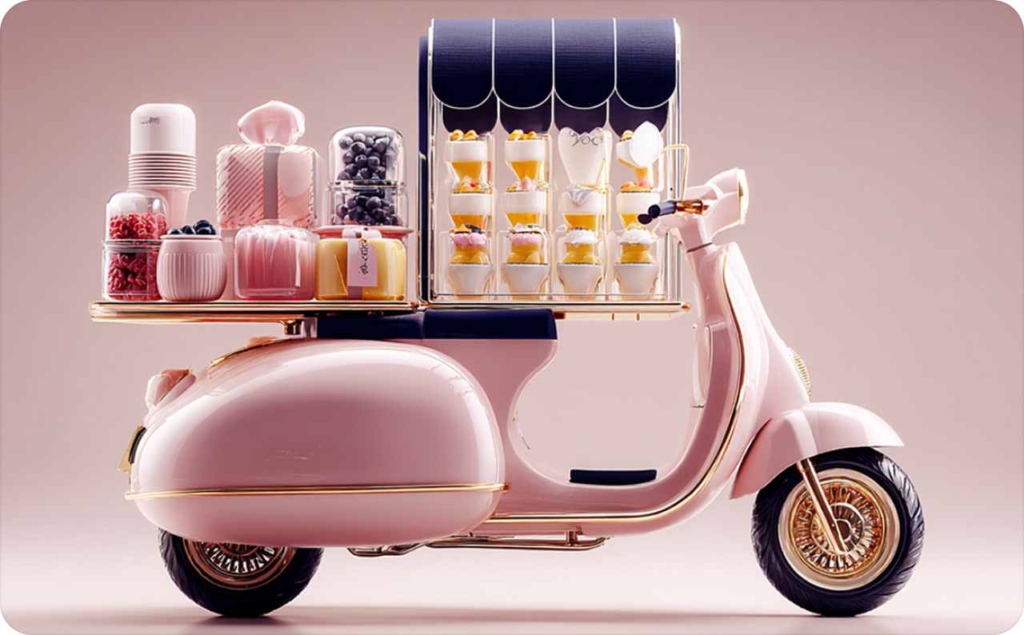
Traditional vs. Digital food ads
Traditional food ads are static formats like print menus, magazines, billboards, and TV. They offer wide visibility and target by location—great for building brand awareness and driving local traffic. But they lack real-time data and can’t be adjusted after launch.
Digital food ads are dynamic and data-driven. They allow targeting, retargeting, A/B testing, and real-time optimization. Marketers can track metrics like impressions, clicks, conversions, and cost per acquisition. Digital also connects with apps, ordering systems, and CRMs.
Example:
KFC’s “Fried Chicken-Scented Firelog” used bold offline ads to attract attention and digital channels to go viral and track results. It combined sensory appeal with measurable performance.
Top food ad examples
From nostalgic revivals to shock-value storytelling, these food and beverage campaigns showcase how creative bravery drives real business results. Whether you’re scaling a DTC brand or refreshing legacy positioning, these examples reveal what happens when ads break formulas and connect on a human, cultural, or emotional level.
Burger King: Moldy Whopper
Burger King showed a Whopper decaying over 34 days to prove it had no preservatives — breaking fast food norms with raw transparency.
Strategic move:
Tied to their clean-label promise, the campaign positioned Burger King as a healthier, more honest option. The shock factor was designed to earn viral attention and shift brand perception.
Results:
- Won multiple Cannes Lions Grand Prix awards (Outdoor, Print)
- 8.4B earned media impressions
- +14% brand recall in key markets
Impact:
Boosted Burger King’s image as bold and authentic, especially with younger consumers who value realness.
Key takeaway:
When your mission matches your message, bold creative pays off. Visual proof beats perfect polish.
Pizza Hut: “Book It” nostalgia revival
Pizza Hut brought back its classic “Book It” reading program with ‘80s-themed visuals to tap into childhood memories and reconnect with millennial and Gen X families.
Strategic move:
Used nostalgia and limited-time menu offers to drive emotional engagement and family visits.
Results:
- Finalist at 2022 Effie Awards (Brand Revitalization)
- Boosted in-store visits
- 3.2x increase in social media engagement
Impact:
Reinforced Pizza Hut’s family-focused brand while giving its legacy a fresh, modern twist.
Key takeaway:
Nostalgia works when tied to action. Combine emotional triggers with updated promotions to boost loyalty and conversions.
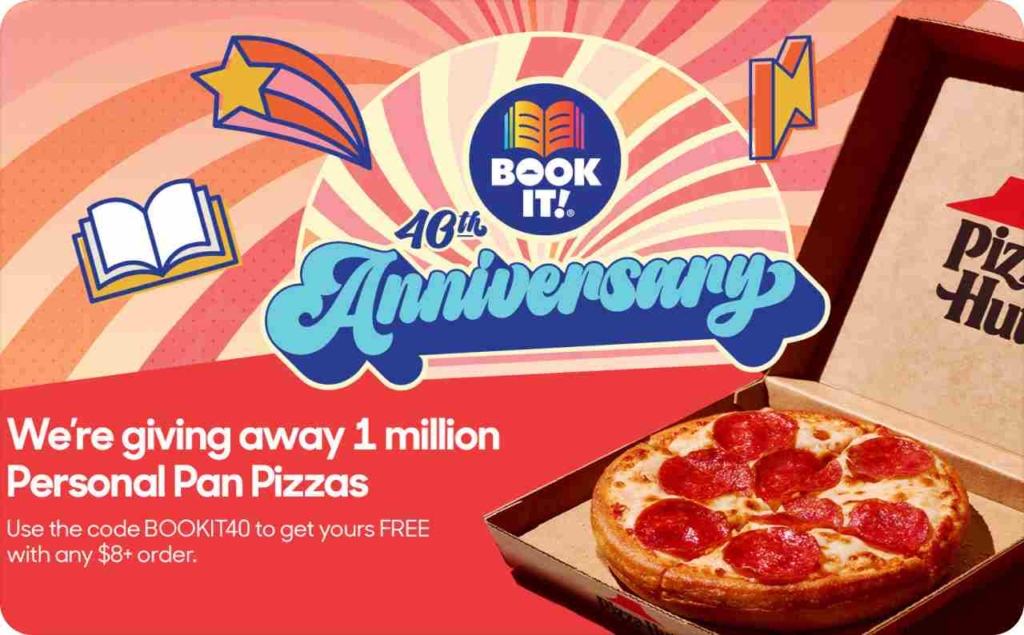
Photo source: Pizza Hut
McDonald’s: Famous Orders
McDonald’s featured real celebrity meals — like Travis Scott and BTS — and launched them with app-only deals, merch, and social buzz to turn fan culture into brand engagement.
Strategic move:
Not just endorsements — these were real orders. It felt personal, authentic, and shareable, driving FOMO and cultural relevance.
Results:
- 2021 Cannes Lions Grand Prix (Creative eCommerce)
- 30%+ app download spikes per launch
- Major Gen Z growth on TikTok and Instagram
Impact:
Shifted McDonald’s into a culture-first brand that thrives on social, mobile, and identity-driven marketing.
Key takeaway:
Authenticity scales when tied to real behaviors. Use owned channels to turn fandom into traffic and loyalty.
KFC: “Finger Lickin’ Good” reboot
During COVID-19, KFC paused its iconic slogan for health reasons — a move that made global headlines and showed brand responsibility.
Strategic move:
Later, the slogan returned with self-aware humor. KFC kept its legacy while updating it for the moment — blending nostalgia with relevance.
Results:
- Finalist at Campaign’s Global Marketing Awards (Brand Evolution)
- 3.5B+ earned impressions
- Boost in brand sentiment at re-launch
Impact:
Positioned KFC as both playful and socially aware. The slogan evolved into a flexible brand asset, not a static tagline.
Key takeaway:
Legacy doesn’t need to be rigid. Smart updates can turn old assets into fresh storytelling tools.
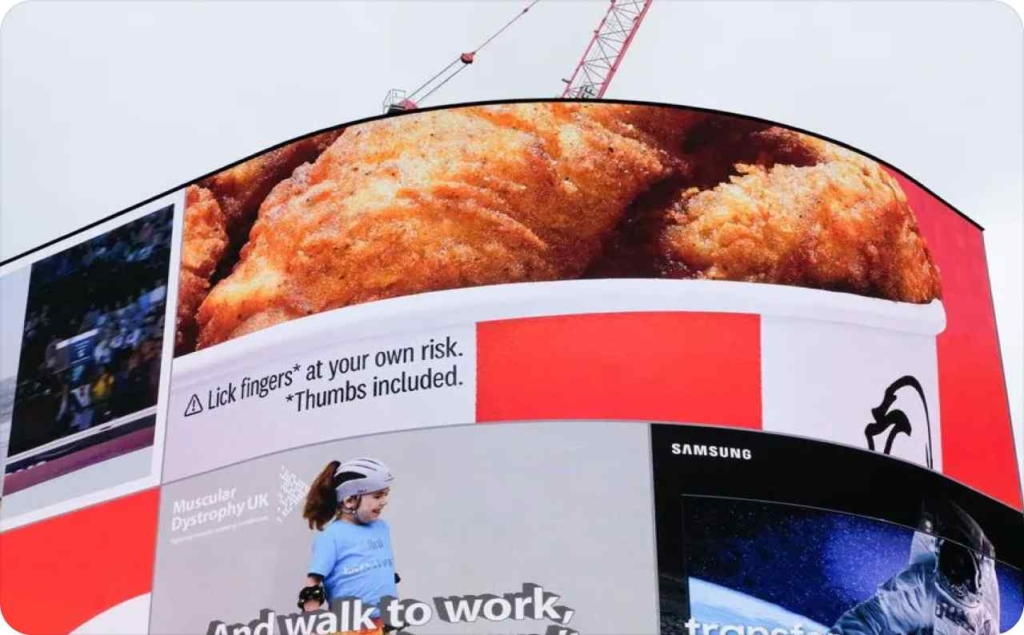
Photo source: Barcroft Media via Getty Images
Taco Bell: “Viva Young” super bowl spot
Taco Bell’s Super Bowl ad showed seniors breaking out of a nursing home for a wild night, set to “We Are Young” — flipping age norms with humor and energy.
Strategic move:
Used older characters to deliver a youthful message about freedom and flavor. It was unexpected, fun, and aligned with the brand’s rebellious tone.
Results:
- Top 5 Super Bowl Ads (Adweek, 2013)
- 11M YouTube views in 72 hours
- Strong engagement from Millennials and Gen Z
Impact:
Locked in Taco Bell’s voice as bold, youth-focused, and culturally aware. It’s still cited as a standout example of humor-driven storytelling.
Key takeaway:
Humor sticks when it hits emotion and timing. Break stereotypes to boost reach and brand love.
Chick-fil-A: “The Whoopsery” holiday film
Chick-fil-A released an animated holiday film focused on kindness, connection, and second chances — opting for emotion over virality.
Strategic move:
Skipped the sales pitch and leaned into heartfelt storytelling, aligned with its community-first, family-focused brand values.
Results:
- Bronze Telly Award (Branded Content, 2022)
- 2.1x higher engagement on YouTube and Facebook
- Boosted sentiment during the holiday season
Impact:
Strengthened Chick-fil-A’s emotional branding and deepened loyalty among families and values-driven audiences.
Key takeaway:
You don’t need noise to win. Quiet, consistent storytelling builds trust — and long-term impact.
Liquid Death: “Murder Your Thirst”
Liquid Death broke the mold by marketing water like an energy drink. With metal-inspired visuals, bold humor, and the tagline “Murder Your Thirst,” it stood out instantly in a dull category.
Strategic move:
Focused on identity, not hydration. The brand mocked wellness clichés and used viral videos, influencers, and edgy merch to build a lifestyle around rebellion.
Results:
- Named one of Ad Age’s Hottest Brands (2022)
- Topped $100M in sales by 2023
- Reached #1 in Amazon’s water category
Impact:
Showed that extreme creativity can build a brand from scratch — and compete with the biggest players.
Key takeaway:
You don’t need a new product — you need a bold story. Own your look, tone, and message without compromise.
Oatly: “Wow, No Cow” super bowl ad
Oatly ran a Super Bowl ad featuring its CEO awkwardly singing about oat milk in a field. It was low-budget, offbeat, and impossible to ignore.
Strategic move:
Rejected polish in favor of authenticity. The brand used discomfort to stand out — signaling its alternative identity to plant-based consumers.
Results:
- Named one of 2021’s Most Polarizing Ads (Fast Company)
- $5M spend generated 1B+ earned impressions
- 280% spike in brand searches after the game
Impact:
Locked in Oatly’s role as a bold outsider in plant-based dairy. The buzz helped propel its IPO shortly after.
Key takeaway:
Cringe can be a strategy. In a crowded space, weird works — especially when it’s self-aware and on-brand.
Poo~Pourri: “Girls Don’t Poop”
Poo~Pourri launched with a bold ad where a glam spokesperson openly talked about bathroom habits. The shock value, humor, and production made it unforgettable.
Strategic move:
Tackled a taboo head-on. Instead of hiding the problem, the brand exaggerated it with satire to normalize conversation and educate buyers.
Results:
- Webby Award winner (Online Commercials)
- 40M+ YouTube views in year one
- $30M+ in DTC sales by year two
Impact:
Turned a niche odor spray into a lifestyle brand. Its fearless tone made it a category leader.
Key takeaway:
Humor can make hard topics relatable. If your message connects to a real pain point, even taboo products can thrive.
Benefits & strategies of effective food advertising
If your food ads aren’t converting, the problem isn’t traffic — it’s visibility. People nearby are ready to eat; they just don’t see you. In competitive areas, getting noticed is the difference between empty seats and steady flow.
1. Use hyper-local targeting to reach high-intent customers
Start with search ads targeting a 3–5 mile radius. Use real queries like “tacos near me” or “lunch specials today.” These are signals of immediate intent — reach them when they’re actively looking to eat.
Tip: Focus on mobile-only placements during lunch or dinner windows.
2. Bridge online clicks with real-world presence
Reinforce digital campaigns with real-life visuals: banners, window signs, and in-store promos. People who see your ad on their phone should recognize your brand when they walk by.
Example: A user sees “20% off tacos today only” in an ad — then sees the same message on your storefront banner. That repetition builds trust and drives action.
3. Create urgency with time-based offers
Time-limited promos perform better. Use countdowns, “today only” offers, or meal-specific deals. They give users a reason to act now, not later.
Fact: Restaurants using localized urgency messaging often see 15–30% more redemptions, depending on platform and creative.
The power of crave-worthy visuals and clear CTAs in food advertising
The Power of Crave-Worthy Visuals and Clear CTAs in Food Advertising
You can have the perfect photo — golden fries, a glistening burger, steam rising just right — and still lose the sale if your ad ends with “Learn more.”
In food advertising, images grab the eye, but words move the hand. Strong visuals don’t just make your ad look good — they trigger appetite
But here’s the catch: attention is short. Once someone pauses, your call-to-action needs to make the next step obvious.
Think:
“Order now” — not “Learn more.”
“Get free delivery” — not “Check our menu.”
“Treat yourself tonight” — not “Discover our food.”
These aren’t just better phrases — they’re frictionless decisions.
Placement matters too. On mobile, your CTA should live where the thumb naturally taps and follow the user’s gaze. When the image stops the scroll, the CTA should feel like the next move.
And don’t overlook authenticity. A well-lit photo can still feel disconnected if it looks staged. Stock visuals often lack the detail and texture that signal freshness and trust.
In fact, Sprout Social found that 63% of people lose trust in a brand if the visual quality is poor — even when the product itself is excellent.
Bottom line:
1. Your image should make people hungry.
2. Your CTA should turn that hunger into action.
When those two elements align, you’re not just promoting food — you’re delivering the first bite before they’ve even clicked.
Leveraging seasonal promotions and social media
Timing isn’t a bonus in advertising, it’s the multiplier. The same ad can flop in February and sell out in July. That’s why pairing your offer with real-world moments makes it more than relevant it makes it necessary.
People don’t wake up wanting your product. But they do want something that fits the moment.
When you align your offer with a holiday, weather shift, or cultural event, you turn passive scrollers into hungry buyers. Seasonal campaigns work because they tap into existing behavior and expectations.
Examples:
- “Fall Harvest Bowl—Only Until Thanksgiving”
- “Free Sundae This Weekend—Celebrate National Ice Cream Day”
- “Game Day Wings Bundle — Preorder for Sunday Kickoff”
These aren’t gimmicks. They’re moment-driven prompts that make people act now, not later.
Even the best seasonal offer fails if it’s delivered too late or to the wrong crowd. That’s why social platforms, especially TikTok, Instagram Reels, and Facebook Stories are essential for getting in front of people when they care most.
Use the tools the platforms give you:
- Countdown stickers to build urgency
- Geo-targeting to show location-relevant deals
- Seasonal hashtags to ride trending moments
- Pinned posts or Stories Highlights to hold attention across the season
Platform-native features make your ad feel like part of the moment, not an interruption.
For example, Chick-fil-A’s Peach Milkshake campaign only runs in summer. They use Instagram geo-ads, branded visuals, and scarcity messaging. The result? Long lines and consistent mobile order spikes.
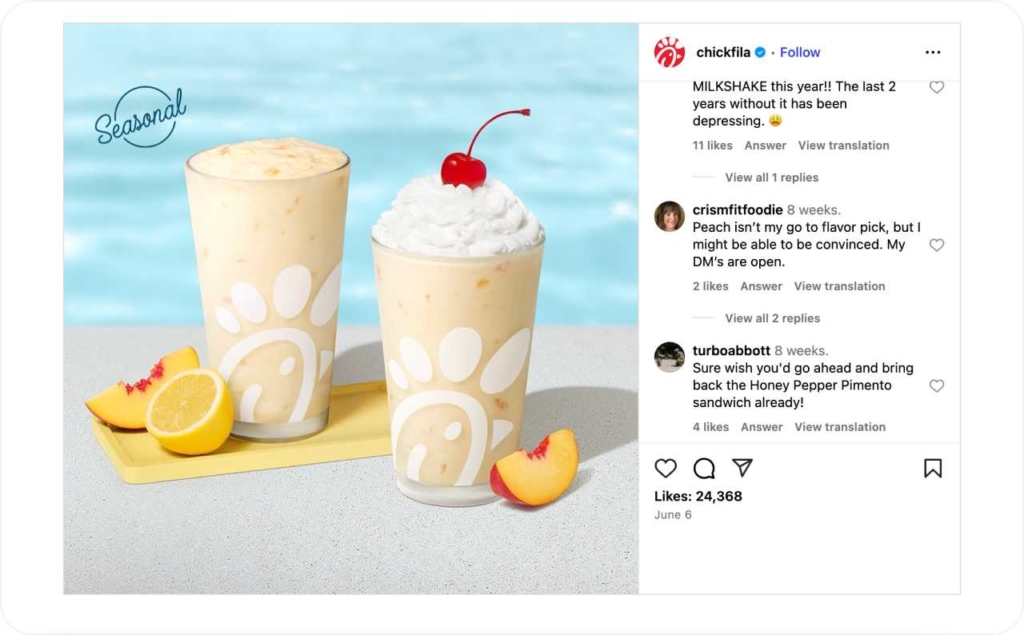
Photo source: @chickfila on Instagram
Creative insights behind successful food ads
The best food ads don’t just look good—they make people hungry. Behind every scroll-stopping image is a mix of smart composition, lighting, and styling that turns everyday dishes into irresistible cravings.
Effective visuals start with clear composition. Keep the shot clean and focused — one dish, one message. Highlight the most tempting part: the melted cheese pull, the glossy glaze, the steam rising off a fresh bowl of soup. This is your hero element—build the frame around it.
Tools That Make a Difference
You don’t need a studio to shoot great food ads. A simple kit can go far:
- Macro lens for rich texture and close-up detail
- Softbox lights to soften shadows and bring out color
- Neutral backgrounds to keep the focus on the food
- Food-safe sprays to simulate steam or moisture
These tools help create mood and appetite appeal without overwhelming the viewer.
Over-staged food can feel fake and disappointing. Show your product at its best, but make sure it’s real. Use real ingredients. Keep editing minimal. Your goal is to enhance, not deceive.
Professional food stylists use simple tricks — like brushing oil to create shine or using steam wands for warmth, but never to mislead. Visual trust builds brand trust and trust leads to conversions.
How humor and social commentary supercharge food ad impact
Great food ads don’t just show products—they make people feel something. Humor, cultural relevance, and shared values act as emotional triggers that drive attention, recall, and action.
Some of the most effective food campaigns use humor to create differentiation. The Old Spice × Arby’s collaboration worked because both brands share a tone built around exaggeration and parody. The humor didn’t feel offbeat—it felt expected. That alignment is what made it memorable.
Humor succeeds when it reflects your brand voice and speaks the language your audience already responds to. Without that fit, it falls flat.
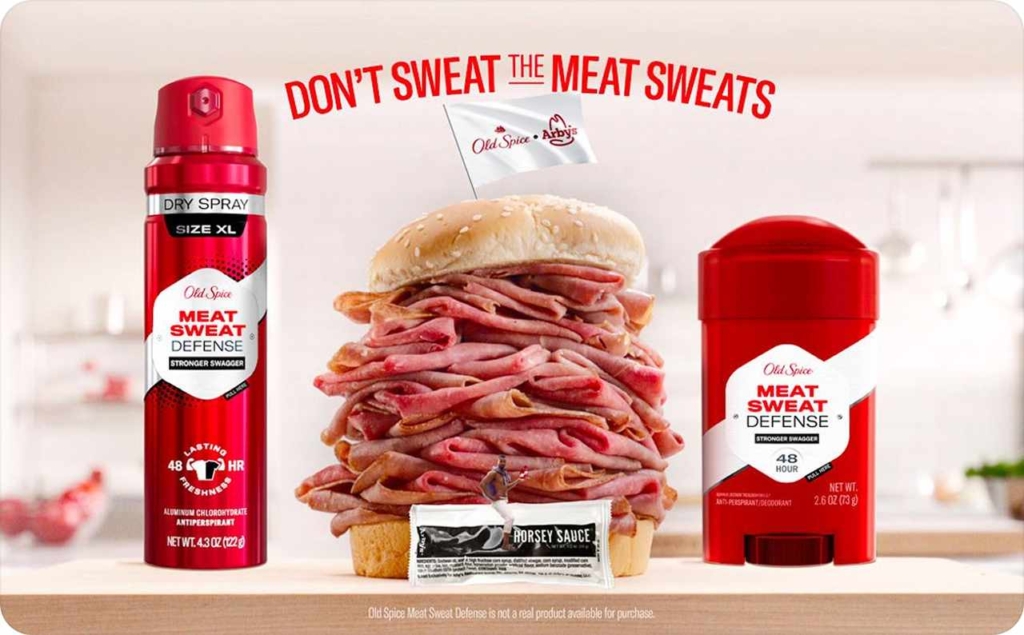
Old Spice and Arby’s collaboration
Burger King’s “Whopper Neutrality” turned a political topic into a simple, real-world analogy. It educated, entertained, and earned massive media attention—all without feeling forced.
Why it worked:
- The message was easy to understand
- It tied to an actual consumer frustration
- It matched the brand’s rebellious tone
That’s cultural storytelling done with precision.
Not every emotion-based ad lands. A joke that misses or commentary that feels opportunistic can damage credibility. To minimize risk:
- Test different tones (humor vs. serious) with A/B creatives;
- Gut-check against your brand’s identity.
- Launch when the timing supports — not distracts from the message.
Emotion works best when it’s earned, not manufactured.
Emotional campaigns often outperform standard promos. On platforms like TikTok, Instagram Reels, and YouTube Shorts, content that connects—fast—is what drives clicks, saves, and shares.
If your ad makes people smile, nod, or think, they’re more likely to remember you.
How to create high-converting food ads (step-by-step)
In food advertising, visuals spark the click, but strategy drives results. To create scroll-stopping, conversion focused ads, you need more than pretty pictures. You need a system that blends brand clarity, platform behavior, and performance optimization.
1. Start with a clear, measurable campaign goal
Every decision—from your headline to your layout—should support one business objective:
- Increase in-store visits
- Boost delivery or pickup orders
- Promote a new menu item
- Build awareness in a local area
Tip: Frame your objective in terms of behavioral outcome. “Get more clicks” is vague. “Increase delivery orders from TikTok ads by 20%” is focused and trackable.
2. Anchor the ad in a strong, singular value proposition
Choose one thing to highlight. Not five. Just one.
That could be:
- A limited-time seasonal combo
- A viral item with social proof
- A signature sauce or recipe
- A locally loved ingredient or story
Why it matters: Narrow focus boosts clarity and recall. Audiences scroll fast—confusion kills engagement. Build your copy and visuals around that one hook. Reinforce it in headline, video overlay, voiceover, and CTA.
3. Build Creative for instant appetite appeal
Your visuals must trigger a craving before the viewer even thinks. That’s not aesthetics—it’s behavioral design.
High-performance visual techniques:
- Macro lens detail – Highlights texture, layers, and freshness
- Natural light – Makes food feel real, not plastic
- Neutral backgrounds – Keeps visual hierarchy clean
- Motion cues – Steam, sauce pours, slow-motion cheese pulls = sensory immersion
- Branded elements – Subtle logos or colors build recall across campaigns
Platform fit matters:
- Use vertical video (9:16) for TikTok and Reels
- Keep visual movement in the first 2 seconds
- Add captions or overlays for sound-off viewing
- Show the offer before the scroll skips
These choices aren’t decorative—they’re functional. They increase view time, click-through rate, and retention.
4. Test creatives early and often
You can’t scale what hasn’t been validated. Use structured A/B testing to identify your top performers—then double down.
Variables worth testing:
- CTA text: “Order Now” vs. “Get It Delivered”
- Format: Static carousel vs. motion-based Reels
- Hook: Offer-driven headline vs. flavor appeal
- Layout: Text overlay vs. clean imagery
Tools:
- Meta Ads Manager → for structured ad set tests
- TikTok Promote → great for early trend validation
- Google Display Experiments → for multi-variant testing
Pro tip: Test fast with small budgets. Use test winners to scale across platforms or geo-segments.
5. Measure the Metrics That Matter
Your creative is only as good as the results it drives. Focus on bottom-line metrics, not surface stats.
Track:
- CTR (Click-Through Rate) → Is your ad compelling?
- Video completion rate → Are viewers staying?
- CPC / CPA → Are you spending efficiently?
- Conversion rate → Are you turning views into actions?
Skip vanity metrics like reach or impressions unless you’re explicitly running a brand awareness campaign.
Tip: Tie each metric to your initial goal. If your objective is delivery orders, optimize for cost per order—not likes.
6. Refine with data, not assumptions
Creative performance decays quickly. Top brands treat ads like products: always iterating, always learning.
What to refresh:
- Visuals after fatigue sets in (watch frequency & CTR drop)
- Copy to match seasonality or offer changes
- Format based on placement (Reels vs. Stories vs. Feed)
- Audience based on conversion trends
Bonus tip: Create a “creative intelligence” system—document what works (and why). Over time, you’ll build your own performance playbook tailored to your brand’s audience.
Final thought
The difference between good and great food ads isn’t budget — it’s clarity, emotional impact, and iteration. Pair crave-worthy visuals with performance data, and your ad becomes more than content—it becomes a conversion asset.
Create irresistible food ads with AI
When people see food, they act fast. Whether you’re promoting a new menu item, pushing delivery orders, or launching a food brand online, Zeely helps you create delicious-looking ads in minutes with ads generator — without hiring a designer or video crew.
From sizzling entrees to sweet treats, showcase your food in its best light and drive more orders across every channel.
Why it works for food and restaurant marketers
- Create mouthwatering ads in minutes. With Zeely AI static ads creator you can whip up professional-looking visuals in seconds — no editing software needed. Just choose among food templates the one that suits you the most
- Drive more orders, reservations, or visits. Highlight what makes your menu stand out and tempt viewers to order, book, or drop by
- Affordable, in-house content creation. Forget agencies and photo studios — you can build polished campaigns on your own, without breaking the budget
- Sell where people scroll and search. Publish platform-perfect ads on Instagram, Facebook, TikTok, YouTube, Google, and food delivery platforms
- Test flavors, formats, and promos. Quickly generate and compare up to 20 ad variations for a single dish, offer, or service — great for specials or seasonal menus
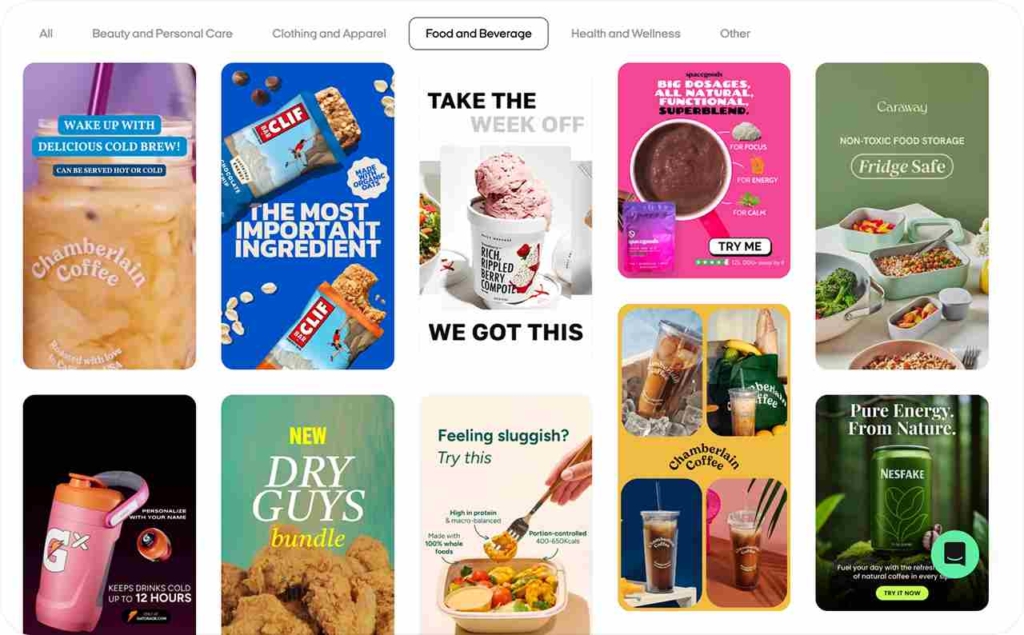
Features crafted for food businesses
- 100+ food-specific templates. Designed for cafes, restaurants, meal kits, dessert brands, food trucks, and CPG products — updated regularly
- Tempting headlines and messaging tools. Instantly generate appetizing headlines, menu callouts, and limited-time offers — all crafted to boost clicks and appetite
- Lifelike video hosts to introduce your brand. Use human-style video presenters to promote dishes, explain ordering steps, or share your culinary story
- Edit visuals for flavor and flair. Remove distracting backgrounds, sharpen product images, and adjust colors to make every dish pop
- Post directly to your socials. Launch ads to Facebook and Instagram right from Zeely — no exporting or switching tools
- Tell your food story. Create short video scripts that show where your ingredients come from, highlight your chef’s process, or spotlight local partnerships.
Built for restaurants, food startups, and growing kitchens
Whether you’re a solo chef, small café, or packaged goods brand looking to scale, Zeely helps you market your food beautifully and efficiently. Plans start at $29.95/month, with more templates, visuals, and features available as you grow.
Why food brands choose Zeely
Good food sells itself — but great ads help it sell faster. Zeely lets you share your flavor, story, and brand without needing a full production team. From first-time food trucks to established eateries, Zeely helps you turn meals into marketing that works.
Conclusion
In today’s saturated feed, standing out takes more than great visuals. The most effective food ads are built on clear positioning, audience insight, and creative execution aligned with real business goals.
From innovative seasonal campaigns to thumb-stopping design techniques, what separates good ads from great ones isn’t guesswork—it’s structure. Successful brands don’t rely on trends. They lead with a strong value hook, test what works, and adapt based on performance—not opinion.
If you remember one thing: Effective food advertising isn’t a creative act—it’s a strategic system. And that system is yours to build.
Also recommended



